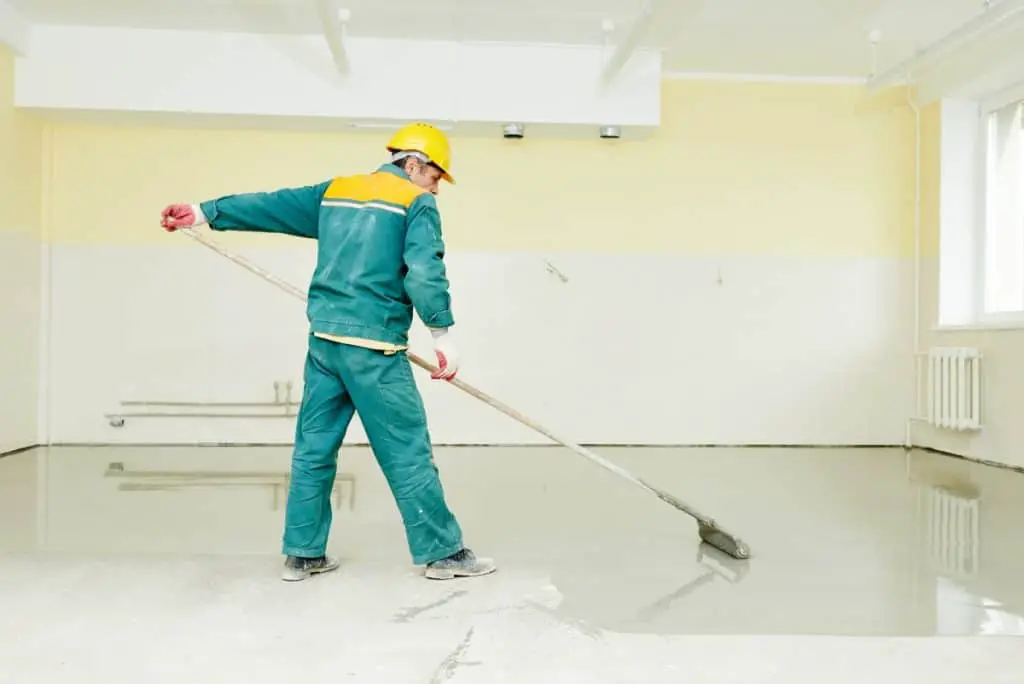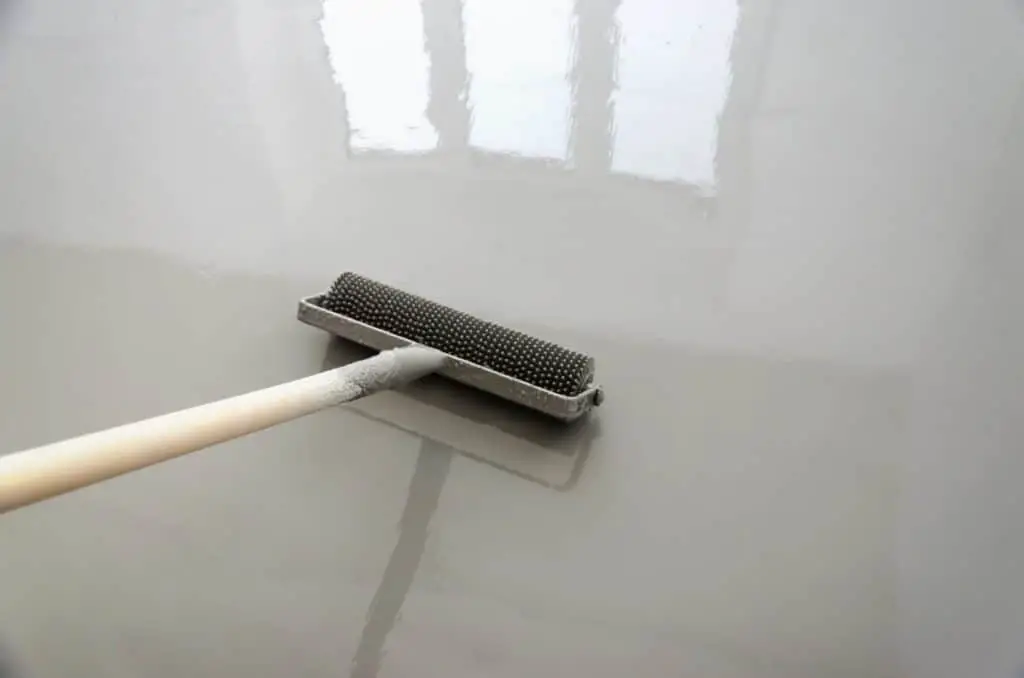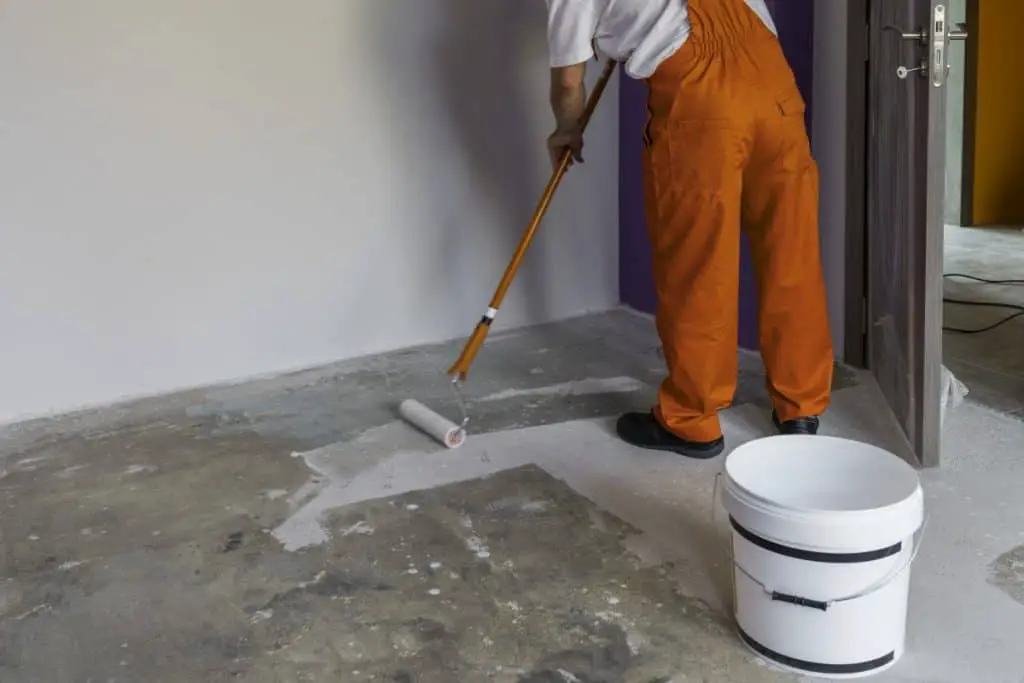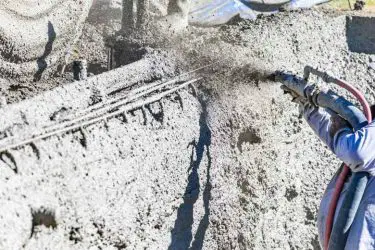Concrete is a durable material that we have been using through the ages because it can last through the ages. But even with its strength, it can be susceptible to spalling (cracking and fracturing), mold, UV ray damage and much more if not taken care of.
Staining concrete can provide the protection it needs to continue to look good and have the needed strength to support whatever need you have.

Table of Contents
Different Types Of Stains
There are 3 different types of stains that you can use to treat your concrete based on your preference. There are film-forming, penetrating, and acid stains for concrete.
Film Forming Stains
Also referred to as a topical sealer or coating, film-forming stains/sealers are sealers containing acrylic, exposes, and urethanes with acrylic being the most popular to use. These substances form a coating or film (hence the name) upon the surface of the concrete to protect it from outside hazards.
This type of stain almost acts like a raincoat or a rubber glove; it repels the water from being able to penetrate the concrete. This type of stain is thin on the surface of the concrete and is available in solvent and water-based formulations based on your preference.
Film-forming stains can be used on both exterior and interior concrete.
Recommended Product
Benefits And Drawbacks

Choose a film-forming concrete stain if you are looking for more of a wet look to your concrete because the finish of this sealer is very glossy.
The solvent-based formulations of film-forming stains will also enhance the color of your concrete due to its high glaze effect as to the water-based sealer.
It is very easy and cheap to apply a film-forming concrete sealer so this product would be better for people who aren’t too experienced or don’t have too much time to spend on a project. Film-forming concrete stain actually dries to the touch within an hour.
There are some drawbacks to using a film-forming stain. While applying a solvent-based film-forming sealer, the stain can give off very strong vapors and odors and can be hazardous and unsafe to one’s health.
If used inside, make sure there is proper ventilation (open windows and doors, fans, etc.). These fumes are also flammable so if they are trapped in an enclosed space, they can ignite and explode if exposed to any kind of spark.
Water-based film-forming sealers are much milder and only have the odor of paint used for interior houses and are not flammable like solvent-based sealers.
Therefore, it is recommended to use solvent-based film-forming stains outside (they also perform better than water-based when it comes to the outdoors) and water-based stains inside.
Due to the thinness of acrylic film-forming sealers, they are more easily worn and have to be reapplied more frequently than other concrete sealers.
Penetrating Stains
Penetrating stains, also known as impregnating concrete sealers, include any sealer that uses silanes, siloxanes, silicates, and siliconates to penetrate the concrete to create a chemical barrier to protect it from water and other outside influences.
The chemicals in this sealer chemically react with the concrete to seal in all from within to create an atmosphere that doesn’t allow water to enter. Since all of the nooks and crannies that water likes to seep into are filled with waterproof substances, water is unable to cause the damage it normally would in concrete.
Recommended Product
Benefits
Due to the permeating trait of this type of sealer, penetrating stains are great to protect concrete from outside influences like the freeze-thaw cycle and the corrosion that happens over long periods of time. Also, penetrating stains have long lifespans and don’t peel, delaminate, or wear away.

This type of sealer for concrete provides a nice natural to a matte finish that won’t change the look of concrete. Penetrating sealers are also very breathable which allows water vapor to escape if it happens to sink in.
Acid Stains
Acid stains give your concrete a very much needed protective layer while also providing a change of color to update its appearance. Metallic acid salts and hydrochloric acid that can be found in the stain react with the lime found in the concrete to tint the color of the concrete permanently altering its color.
These tints of color can change the appearance of your concrete to make it resemble marble, stained wood, and even other nonconventional surfaces like leather.
Read more: Selecting the Perfect Acid Stain for Your Concrete Work
Recommended Product
Pros and Cons
Acid stains are great for breathing life into any concrete surface that is dull or muted. Like a penetrating stain, this sealer permeates the concrete’s layers so it is very resistant to UV rays and normal wear and tear.
Acid stains are great for indoor and outdoor use. Although it is the most expensive of the stains used to treat concrete, the results are altering and stunning. We also wrote an article to help you get a better understanding of the actual cost of acid staining concrete, which might be worth checking out before you proceed.
Amount Of Stain Needed
This is entirely dependent upon the project at hand, but usually, a gallon of stain can cover 200 square feet. Depending on the type of stain chosen, multiple layers are required and more gallons will be needed to completely cover and complete the concrete project.
What is also needed to take into account is the coverage rate of the concrete. That is to mean, how much stain will be absorbed by the concrete based on how porous it is. Usually, older concrete is more porous so it will require more stain to complete the project.
Also read: Acid Staining Old Concrete: Is it a good idea? Plus 10 tips!

How to Stain Concrete With Film Forming Sealer
1. Choose a day that is not too cold or too hot
Before you start to apply the stain, you need to make sure you are operating under the correct conditions. The ideal temperature to seal concrete is around 70 degrees Fahrenheit. You can seal concrete in temperatures as low as 45 degrees Fahrenheit, but the cooler it is, the longer it takes for the stain to dry.
You can also apply stain in temperatures as high as 90 degrees, but the hotter it is, the less the stain is able to penetrate the concrete and be able to protect it correctly.
2. Clean the surface thoroughly and let it dry
To effectively stain concrete you need to prep the surface. Make sure you clean the concrete a couple of times before you apply the concrete stain. Whatever you don’t clean out of the concrete will be sealed for a very long time, so make sure you take your time scrubbing it.
Make sure the concrete is bone dry for about 24 hours before starting to apply the sealer for it to actually work. White spots can occur if not fully dry due to the stain’s sensitivity.
3. Apply a thin layer of film-forming stain
While working with film-forming stains, it is extremely important to work in thin layers. If the stain is applied too thick, bubbles will form in the sealer and destroy the pristine glossy look or the stain could form cracks easier. Spray the stain onto all of the concrete surfaces in a thin layer, making sure to cover every part of it.
4. Let it dry completely and apply a second coat
After applying the first thin layer of film-forming stain, wait 4-24 hours for it to completely dry before applying a second thin coat. Since the layers are very thin, a second coat adds more protection to the concrete’s surface to keep it intact for a longer period of time.
5. Wait 24-48 hours before using the concrete
Once you have applied all of the layers of stain needed to ensure that your concrete is impervious to the outside or inside forces, you will need to wait 24-48 hours before you can start to use the concrete. After that, it is free to park a car on, stand on, play on, or put furniture on.
How to Stain Concrete With Penetrating Sealer
Applying a penetrating stain to concrete is very similar to applying a film-forming stain with a couple of differences.
You will still need to have the correct temperature to make sure it applies and dries correctly, as well as ensuring that the surface is clean and dry before applying anything to it.
Instead of applying 2 thin coats of stain to the concrete like as you would do when working with a film-forming stain, apply one layer of penetrating stain to concrete.
Once the penetrating stain has been sprayed onto the concrete, use a paint roller to ensure that the concrete is coated evenly. Make sure you coat every part of the concrete with the stain so that it can properly sink into the concrete.
Residue, that looks milky white as shown in the video, will most likely be left behind, but it won’t affect the desired outcome of the concrete.
This type of stain dries very fast, so it will only take a minute for it to be dry to the touch.
To make sure that it is completely dried on the surface level and in the concrete, wait 3-5 hours until you use it. To walk on it, you will need to wait 6-8 hours and then about 24 hours until you can put anything like a vehicle on it.
How to Acid Stain Concrete
1. Smooth Out Rough Patches
To achieve the wanted outcome of a transformed piece of concrete, you will need to first smooth out any really rough patches so the stain can be applied correctly and evenly. Grinders are preferred to even out the surface of the concrete, but even a palm sander could work.
2. Clean the Concrete Thoroughly
Just like other types of stains used to seal concrete, the surface of the concrete needs to be cleaned thoroughly and most likely multiple times to prepare it for the stain that will be placed on top.
Whatever you don’t clean out of the concrete will be sealed for a very long time, so make sure you take your time scrubbing it.
3. Let the Concrete Dry for 4-8 Hours
Make sure that the surface of the concrete is dry and has been for about 4-8 hours before proceeding to the next step. The concrete must be dry before applying the stain because it will trap all of the water moisture inside and completely corrode the concrete in time.
4. Protect Nearby Surfaces With Plastic
In order to preserve all of the items and areas around your concrete, you will need to place a protective covering around those surfaces. You can put up plastic to make sure those areas don’t get harmed by the chemicals you will be placed on the concrete.
5. Dilute the Acid Stain Concentrate
Since the concentration of the acid stain you typically use is pretty strong, it needs to be diluted. Follow the instructions on the back of the acid stain that you buy to do it correctly. All acid stains require different ratios of water to concentrate.
6. Apply the Acid Stain
In order to achieve an even distribution of hues in your concrete, apply the acid stain by spraying it evenly edge to edge. This will ensure that you have covered every part of the concrete surface with the same exact amount of stain.
If the surface you are working with is smaller, you can just apply the acid stain to the concrete using a paintbrush and bucket/cup to hold the stain.

7. Brush the Acid Stain Into the Concrete
To guarantee the even distribution of the stain, use an industrial broom to brush the acid stain into the concrete. This will also help the stain to penetrate more into the concrete to secure the longevity of the color of the stain.
8. Wait 5-24 Hours to Let the Stain Set and Dry
With all acid stains, wait around 5 to 24 hours to fully dry. During this time, the metallic acid salts and hydrochloric acid in the stain react with the lime found in the concrete to tint the color of the concrete and protect the surface.
9. Apply an Alkaline Neutralizing Solution
As the chemicals in the acid stain react with the lime in the concrete, the chemical reaction changes the color of the concrete with time. Due to the chemical nature of an acid stain, you will need to apply a neutralizing solution to the concrete to stop the chemical reaction that is happening in the concrete.
Once the concrete has achieved the desired color, apply an alkaline neutralizing solution to stop it from getting darker. Apply this alkaline solution abundantly to the concrete and scrub it fully into the concrete so that it can soak in and neutralize the chemical color reaction.
10. Rinse the Area With Water
After the alkaline neutralizing solution has been applied and brushed into the concrete, rinse the area with water to clean it off any lasting solutions and chemicals. This step might need to be repeated multiple times depending on how willingly the acid, the alkaline neutralizing solution, and its residue wash away.



